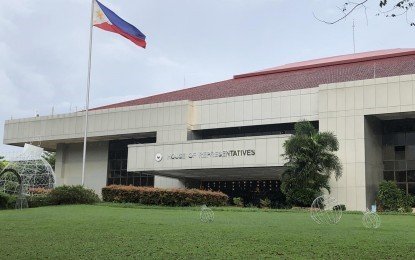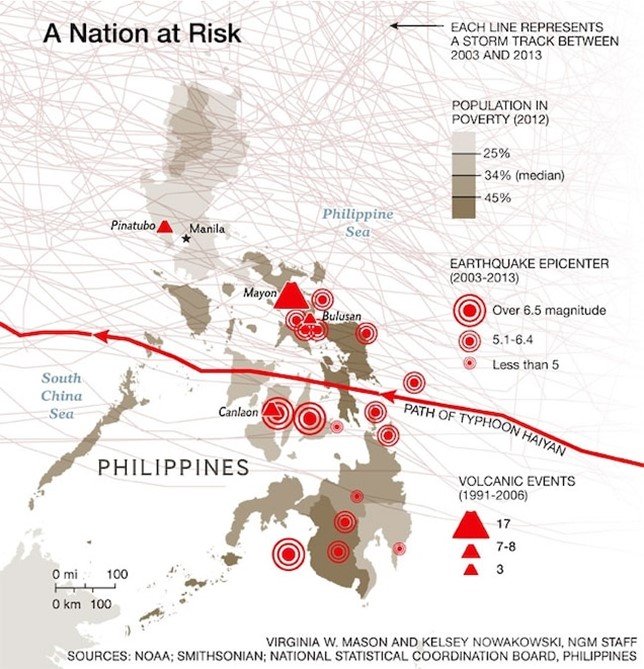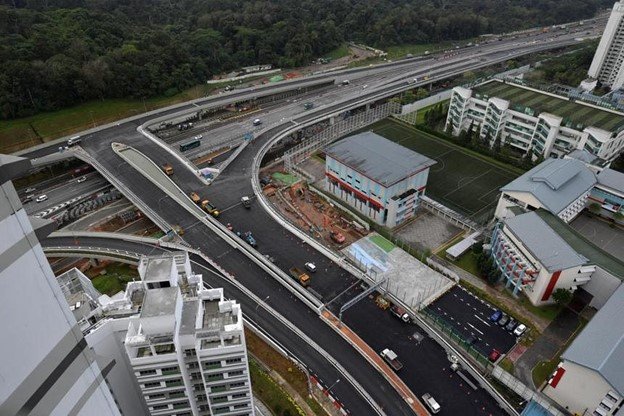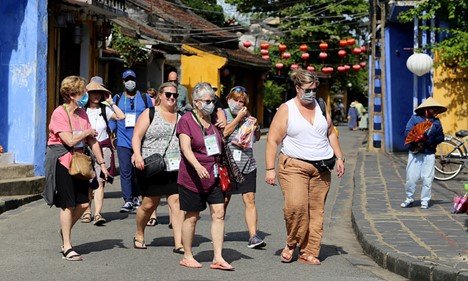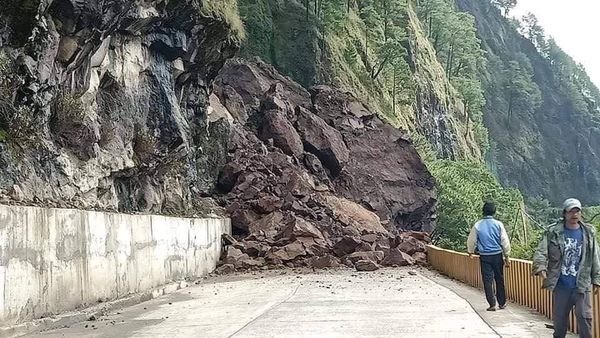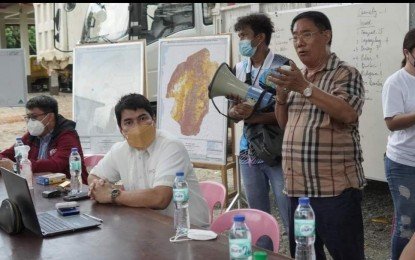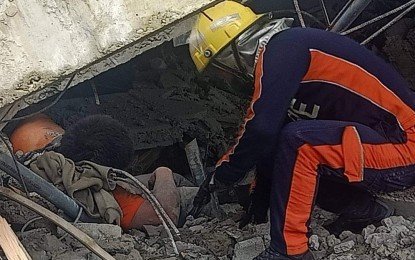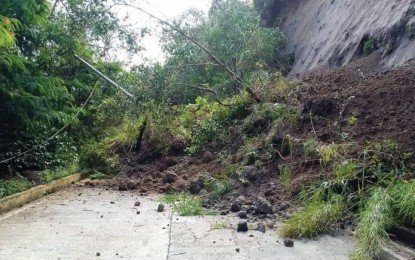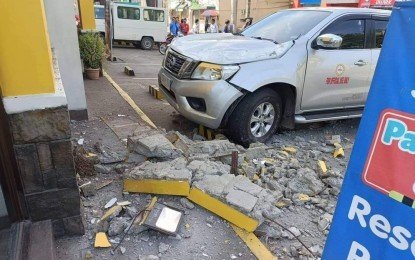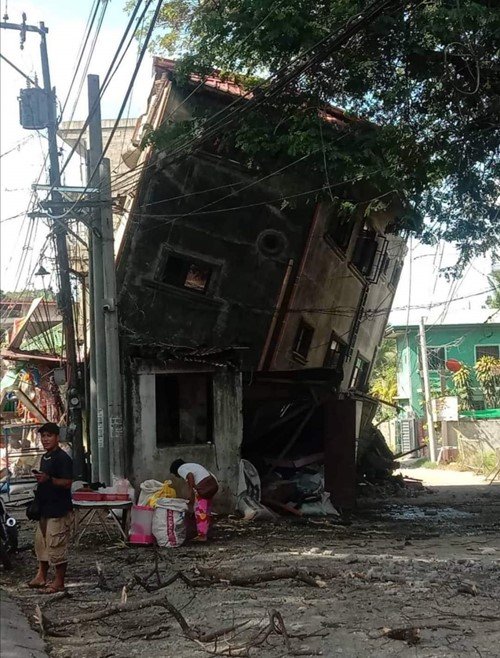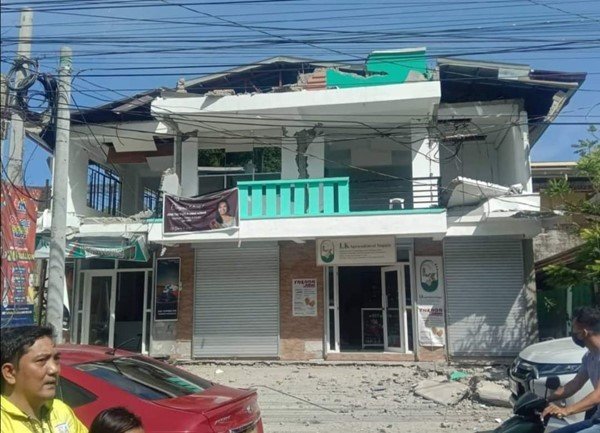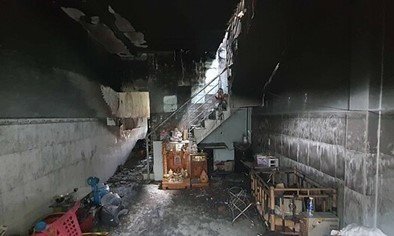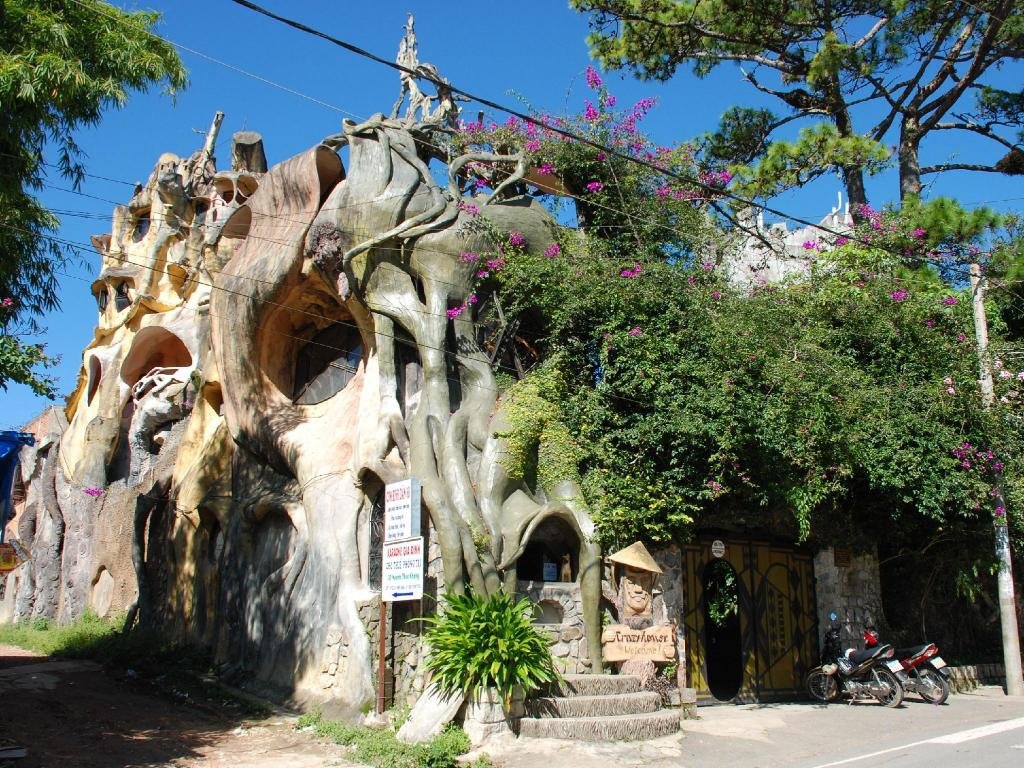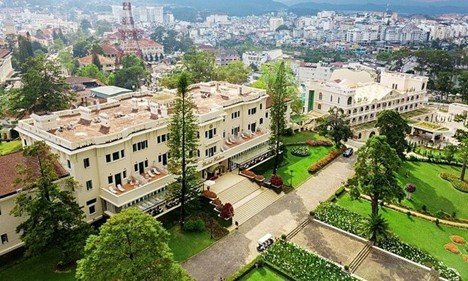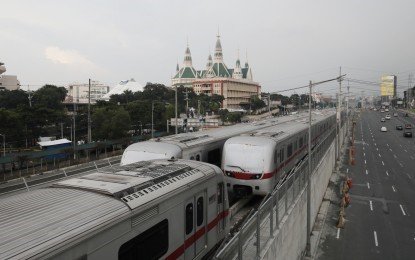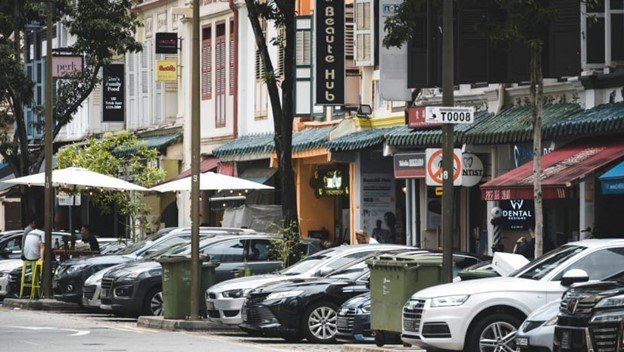-
Posts
2,719 -
Joined
-
Last visited
Content Type
Events
Forums
Downloads
Quizzes
Gallery
Blogs
Everything posted by ASEAN NOW News
-
If you don’t have a head for heights, then maybe this record breaker is not for you. On May 28, Sơn La provincial authorities officially inaugurated the Bạch Long Bridge (White Dragon) in Mộc Châu. Recording breaking glass bridge At the same time the bridge received recognition from the Guinness World Record as the world’s longest glass bridge, at 632 meters long. The previous record-holder was a 562-meter bridge in the Huangchuan Three Gorges-Longtan Cultural Ecotourism Area in Guangdong Province, China. Bạch Long Glass Bridge, which is 2.4 meters wide, consists of a 290-meter structure that crosses over the two sides of a gorge — whose depth is up to 150 meters — and an extended glass pathway built along the cliffside with a total length of 342 meters. The bottom glass is three-layer super safety glass The bottom glass is three-layer super safety glass from the French company Saint Gobain. Tourists can walk along the 632-meter glass bridge above the verdant forest. The bridge is also equipped with entertainment technology projecting 60 different visual and audio effects. Walking toward the other end of the bridge, tourists will reach Mường Móoc Cave, also known as Chim Thần Cave (The Fairy Bird cave), in which one can enjoy a comprehensive view of natural stalactite and murals depicting the lives of ancient Thái communities. During its launch on April 30, Bạch Long bridge attracted 4,000 visitors: and 15,000 more visitors over the following three days. According to local tourism officials, this attraction, along with other facilities in the Mộc Châu Island tourist area, aims to give Sơn La tourism a boost, aiding economic recovery in the province in the post-COVID era. According to the project's investor, the Mộc Châu Island tourist area has cost VND773 billion. Construction of the first phase, which began in 2021, is complete and features multiple facilities, including the Bạch Long Bridge. It's expected to draw up to 700,000 visitors annually and create 500 jobs. Join our 3 x a week Vietnam News, Travel and Expat information newsletter and keep up to date. https://aseannow.com/newsletter.php
-
Electricians fix power cables in southern Bac Lieu Province. Photo by VnExpress/Nguyet Nhi The Ministry of Industry and Trade wants coal-fired plants with a capacity of 14,120 megawatts scrapped from electricity production plans for Vietnam to achieve net-zero emissions by 2050. According to VN Express, the plants were included in Power Development Plan 7 (for 2011-20) and have not been built due to delays. Now, the ministry does not want them to be part of Power Development Plan 8 (for 2021-30), which is being drafted. The ministry also wants to reduce the ratio of coal-fired power sources from 25-31 percent in 2030 to around 10 percent in 2045. No new coal-fired plant should be built after 2030, it said. It wants to increase output from LNG-fueled and renewable plants to offset the cut in coal use. It targets having 12,000-15,000 MW of renewables and 14,000 MW of liquefied natural gas plants in PDP 8. Join our 3 x a week Vietnam News, Travel and Expat information newsletter and keep up to date. https://aseannow.com/newsletter.php
-
NUCLEAR COOPERATION. Philippine Ambassador to South Korea Ma. Theresa Dizon-De Vega meets with Korea Hydro and Nuclear Power Co. Ltd Executive Vice President for Overseas Nuclear Business Division Nam Yoh-Shik, Section VP Kim Yongsoo, and Senior Manager Choi Younghwan in Seoul on July 19, 2022. De Vega was joined by Third Secretary Reisha Olavario and Commercial Counselor Jose Ma. Dinsay. (Seoul PE photo) SEOUL – Philippine Ambassador to South Korea Ma. Theresa Dizon-De Vega met with Korea Hydro and Nuclear Power Co. Ltd (KHNP) executives this month to discuss future Philippines-Republic of Korea (ROK) cooperation on nuclear technology and renewable energy. The KHNP executives include Project and Overseas Nuclear Business Division Executive Vice President Nam Yoh-Shik, Overseas Nuclear Business Section Vice President Kim Yongsoo and Overseas Nuclear Business Section Senior Manager Choi Younghwan. During the call, De Vega affirmed the Philippines’ interest in focusing on a viable and sustainable energy plan and informed ROK that President Ferdinand R. Marcos Jr. himself expressed interest in pursuing nuclear technology and other energy cooperation platforms with South Korea. KHNP is the largest power generator in Korea, producing one-third or around 28 percent of Korea’s domestic demand for power through a combination of nuclear power, hydropower, pumped-storage power, and new and renewable energy. It is also an energy partner of 29 countries for the global power supply. KHNP is a long-time partner of the Philippines on energy-related activities, having led the feasibility studies for the safe use of the Bataan nuclear power plant and the Cagayan Eco Zone. The KNHP likewise shared they are trying to support more experts in the nuclear energy sector and was pleased to share that Korea Electric Power Corporation (KEPCO) International School has a student engineer from the Philippines. The officials looked forward to further strengthening PH-ROK energy cooperation in the future. (PR) Join our 3 x a week Philippines News, Travel and Expat information newsletter and keep up to date. https://aseannow.com/newsletter.php
-
DAMAGED. The magnitude 7 quake left huge cracks in the centuries old Tayum Church in Abra on Wednesday (July 27, 2022). Abra Governor Dominic Valera approved on Thursday (July 28, 2022) a resolution by its Sangguniang Panlalawigan declaring the entire province under a state of calamity. (Contributed photo) MANILA – Abra Governor Dominic Valera approved a resolution by its Sangguniang Panlalawigan on Thursday declaring the entire province under a state of calamity due to the massive destruction caused by a magnitude 7 earthquake that hit Northern Luzon on Wednesday. Resolution 180, series of 2022, was unanimously signed by all the province’s officials in a special session on Thursday to enable the provincial government to immediately address the needs of its people. “Resolved, as it is hereby resolved, to declare the Province of Abra under the State of Calamity to mobilize the Provincial and the 27 LGUs to respond to the immediate needs of Abrenios and for other purposes,” the resolution read. “Resolved further, commitment to this destruction the 58 percent Calamity Reserve Fund is available and authorized to be utilized for the purpose and for other related purposes,” it added. Meanwhile, the province is also requesting immediate assistance from the national government and the different concerned agencies for proper disaster response, relief, rehabilitation, and reconstruction support. The magnitude 7 earthquake that jolted Northern Luzon on Wednesday had its epicenter recorded in Tayum, Abra. The Philippine Institute of Volcanology and Seismology (Phivolcs) has so far recorded 828 aftershocks that ranged from magnitude 1.5 to 5.4, as of 11 a.m. on Thursday, while advising the public that aftershocks may continue for several weeks. The provincial government reported massive destruction in the entire province due to the earthquake. “Initial/progressing report from PDRRMO on damages caused by the earthquake has affected 80 percent of the total population of Abra and major infrastructure facilities both private and government properties were severely damaged,” the resolution stated. The resolution added that a province-wide power outage is being experienced as power lines have been destroyed. “Destruction of houses, buildings, and bridges have paralyzed the operation of business establishments, likewise, displacing a lot of Abrenios as they stay out of their homes without food,” it further said. On Thursday morning, President Ferdinand Marcos Jr. flew to Abra with Special Assistant to the President Secretary Antonio Lagdameo Jr., Secretary Benjamin Abalos Jr. of the Department of the Interior and Local Government, Defense OIC Undersecretary Jose Faustino and Department of Social Welfare and Development Secretary Erwin Tulfo. Marcos personally checked about the affected individuals as he conducted a security briefing with concerned national and local officials and led the distribution of relief goods to the victims. (PNA) Join our 3 x a week Philippines News, Travel and Expat information newsletter and keep up to date. https://aseannow.com/newsletter.php
-
MANILA – Several lawmakers in the House of Representatives on Thursday emphasized the need for the immediate passage of a measure seeking to establish a Department of Disaster Resilience (DDR) to manage the country's disaster preparedness, response, and rehabilitation efforts. Ang Probinsyano Party-list Representative Alfred Delos Santos said the magnitude 7 quake that hit Abra, and nearby areas should be the "last reminder" to Congress on the urgent necessity of creating the DDR. Delos Santos said the chamber could expedite the approval of the bill since it was already approved in the 18th Congress, citing House Rule 10, Section 48, which authorizes the committees to dispose of priority measures already filed and approved on the third reading in the previous Congress. “I was a co-author of the Department of Disaster Resilience (DDR) bill during the 18th Congress. It was approved on third and final reading; so, I add my voice in agreement to the fast-track approach to bills that the House previously approved on third and final reading,” Delos Santos said. A more science-based approach to disaster resilience Davao City Representative Paolo Duterte, Benguet Rep. Eric Yap, Quezon City Rep. Ralph Tulfo, ACT-CIS Partylist Reps. Edvic Yap, Jocelyn Tulfo and Jeffrey Soriano, meanwhile, pushed for House Bill No. 452 that aims to create the DDR. The bill seeks to create an “empowered, highly specialized, science and information and communications technology (ICT)-based and fast and responsive Department of Disaster Resilience, with the clear unity of command which shall be primarily responsible for ensuring safe, adaptive and disaster-resilient communities.” “We should emphasize the science-based aspect of this proposal. With the Philippines among the countries most vulnerable to the destructive effects of climate change, science and technology should play a key role in helping us prepare for possible disasters,” the lawmakers said. Under the measure, the DDR shall manage and direct the implementation of national, local, and community-based disaster resilience and disaster management programs, projects, and activities in collaboration with relevant government agencies, local government units (LGUs), civil society organizations, academic groups, and other stakeholders. Duterte said their proposed measure includes the establishment of a National Disaster Operations Center (NDOC), Alternative Command and Control Centers (ACCCs) in the regions and the Disaster Resilience Research and Training Institute (DRRTI). He said the DRRTI will help develop a highly professionalized corps of officers that will oversee, among others, multi-hazard mapping; risk analysis; and the setting up of a database that includes relevant information from other government agencies and third parties for the DDR to better prepare and respond to natural hazards. The DRRTI also includes the establishment of reliable and up-to-date disaster-related information and communications systems and technologies through close coordination with the Department of Science and Technology (DOST) and academic institutions. “If we are to create a Department of Disaster Resilience, we should make it a strong, dependable agency by employing the latest technologies available. This will ensure that the DDR will be efficient and effective in performing its task of being the country’s main disaster management agency,” Duterte said. Evacuation centers in every city, municipality Speaker Martin Romualdez, Committee on Accounts Chairperson Rep. Yedda Maria Romualdez, and Tingog Party-list Rep. Jude Acidre filed a measure that would make temporary shelters always available for Filipinos under House Bill 16. The bill proposes to establish evacuation centers in every city and municipality that would offer accommodation for people who have been displaced from their homes due to natural or man-made disasters. “Seeking temporary solutions to the displacement of families by using schools as evacuation centers must be stopped. There should be no tradeoff between protecting lives and the education of students. The provision of adequate evacuation centers is of invaluable importance during cataclysmic times," the lawmakers said. To save government expenses, the measure provides that existing structures that could be upgraded to effectively serve as evacuation centers would be designated as such in compliance with the local government unit concerned. The LGUs would be responsible for the operation, supervision, and management of these evacuation centers. The bill has already been referred to the Committee on Disaster Resilience to be deliberated upon by the legislators. Bills promoting disaster preparedness, animal calamity rescue Delos Santos said the Laging Handa bill under House Bill 1923 provides for the integration of basic medical training and disaster awareness or response in all institutions of learning, including but not limited to, schools, colleges, universities, and vocational learning institutions. “The schools would be mandated to integrate into their respective curricula and make available to all its students relevant and updated subjects, units, and electives, or courses, regarding basic medical training, national emergency or disaster awareness, preparedness, and response,” he said. Implementing agencies in HB 1923 are the Commission on Higher Education (CHED) and the Department of Education (DepEd), in coordination with the Department of Health (DOH), Department of Interior and Local Government (DILG), and the National Disaster Risk Reduction and Management Council (NDRMMC). He also pushed for the Animal Calamity Rescue bill (HB 1915) to address the lack of guidelines about the rescue of livestock and working animals during times of calamity. "Many of our fellow Filipinos depend on their animals for their livelihood or business, and their rescue during disasters would reduce calamity impacts on households and enterprises,” he said. (PNA) Join our 3 x a week Philippines News, Travel and Expat information newsletter and keep up to date. https://aseannow.com/newsletter.php
-
Yesterday's damage caused by the earthquake After another earthquake has created havoc this week, people wonder why the Philippines has more than its fair share of natural disasters. Located along the typhoon belt in the Pacific, the Philippines is visited by an average of 20 typhoons every year, five of which are destructive. Being situated in the “Pacific Ring of Fire” makes it vulnerable to frequent earthquakes and volcanic eruptions. According to National Geographic, here they list five reasons the Philippines Is so disaster prone. Warm ocean waters, low-lying coasts, and poverty help explain what makes disasters like Super Typhoon Haiyan dangerous in the Philippines. The unofficial death toll for Super Typhoon Haiyan back in 2013 exceeded 10,000 people in the Philippines, but the country is no stranger to catastrophic natural disasters. From earthquakes to volcanic eruptions to previous super typhoons, death tolls following cataclysmic events in the Philippines tend to be high. Here are 5 reasons why: 1. Warm Ocean Waters Located just above the equator, the Philippines faces the western Pacific without much else in the way to take the force of storms before they make landfall. Those warm, equatorial waters power storms, about 20 typhoons a year. "It has the warmest ocean temperatures in the world. We call it the warm pool around Indonesia and the Philippines," says atmospheric scientist Colin Price of Israel's Tel Aviv University. "You need temperatures above 28°C (82.4°F) for typhoons to form. In the western Pacific, the water's normally above 28 degrees," Price says. 2. Coastal Homes A lot of people live on low-lying coastal islands in the Philippines, with more than 60 percent of the population living in coastal zones, according to World Bank estimates. Storm surges for landfall of Super Typhoon Haiyan reached 23 feet (7 meters) in some places and were more than 16 feet (5 meters) high. Those waves rolled over low-lying parts of populated islands such as Leyte, home to the coastal city of Tacloban, where the BBC estimates more than 10,000 people alone died. 3. Deforestation In past typhoons, mudslides have killed many storm survivors in the Philippines, notes meteorologist Jeff Masters of the Weather Underground website. Hillsides denuded of trees have fewer roots to hold them together, which can lead to mudslides when they are hit by sudden huge outbursts of rain. Deforestation has caused similar problems in places such as Haiti, where mudslides were triggered by rainstorms. The soil clogged waterways, causing stagnation later linked to cholera outbreaks. 4. Ring of Fire On top of everything else, the Philippines rests on the Pacific’s earthquake and volcano Ring of Fire. Driven by the Pacific's Ocean's crust diving underneath the continents, the result is earthquakes and tsunamis striking the Philippines with regularity. A magnitude 7.1 earthquake this week so far has killed seven people and has caused millions of Pesos in damage. 5. Underdevelopment The young, poor population of the Philippines has increasingly shifted to coastal regions, where rapidly constructed housing and inadequate evacuation plans may have played a role in these disasters. Indeed, reports during the 2013 Super Typhoon Haiyan stated that people died in shelters too weak to withstand the storm surge and high winds of the super typhoon. Over the long term, the Manila Observatory says that the combination of poverty and population shifts puts the Philippines among the Top 10 worldwide nations at risk of coastal flooding. Seems President Marcos JR has his work cut out just a few days after taking office. Join our 3 x a week Philippines News, Travel and Expat information newsletter and keep up to date. https://aseannow.com/newsletter.php
-
The flyover linking Senja estate to KJE, seen on July 25, 2022. ST PHOTO: ALPHONSUS CHERN SINGAPORE - A pair of flyovers proposed by MP Liang Eng Hwa a decade ago are slated to open soon to give residents in Bukit Panjang better access to the Kranji Expressway (KJE). In response to queries from The Straits Times, the Land Transport Authority said on Wednesday (July 27) that the flyovers, which form a traffic interchange at Senja Road and the KJE, are mostly completed.
-
Hoang Thien, 33, says he invested US$35,000 in a cryptocurrency game and broke even in just 22 days. Most of the money went toward NFT shoes - virtual items that allow owners to jog and earn cryptocurrency rewards - the Hanoian says. "A pair of shoes costs $1,000, and I’ve spent a total of $30,000 on them." The rest was spent on buying 30 smartphones and hiring professionals and students to run for him. Hoang Thien, a Hanoian crypto investor, bought 30 smartphones in the hope of making money quickly from an NFT game. Photo courtesy of Thien Despite making $900 a day and breaking even in just 22 days, Thien plans to sell all the NFT shoes soon and find new games to invest in. "The life cycle of a NFT game is short, so I will exit once it peaks." This is not the first time Thien has invested in NFT games, and he has earned thousands of dollars using the same tactics. VN Express reports that it is not uncommon for people to try and take advantage of being first movers like Thien, Vu Thanh, administrator of a play-to-earn gaming community, says. "They always want to hunt down new projects, invest early and exit once they make a profit before moving to a new one." But not all can make money quickly from these games, and many claim to have lost their entire investment. Tran Cong, an investor from HCMC, bought three NFT cars for $3,000 in a crypto racing game and hoped to make a quick profit, but the game turned out to be a scam, with the developers disappearing days after he joined. The value of the game's token has dropped to nearly zero. "The tokens I earned from the game now are worthless, and I can't sell the cars I bought. Basically, I’ve lost all my money." Before making a fortune from NFT games, Thien himself lost $20,000 in them. Experts warn that many NFT games in Vietnam are just disguised Ponzi schemes in which early investors get money from later ones. "When first launched, in-game tokens and items are relatively cheap, and their prices will rise in proportion to the games’ popularity," The Vi, an experienced investor, says. "But a few months later their prices will peak and then fall due to lower demand, which will cost later movers a fortune." Around 23 percent of Vietnamese invest in or play NFT games putting the country in the global top five, according to Australian data analyst firm Finder. Join our 3 x a week Vietnam News, Travel and Expat information newsletter and keep up to date. https://aseannow.com/newsletter.php
-
American tourists in Hoi An ancient town in central Vietnam, April 2022. Photo by VnExpress/Dac Thanh Economical living costs and diverse travel experiences make Vietnam one of eight most ideal countries for Americans to move to after retirement, according to the Travel+Leisure magazine. "Vietnam is a very affordable place to retire, especially for adventurous retirees who appreciate the country's beaches, scenery, food, history, and culture," the U.S. magazine said. VN Express reported that the overall cost of living is about 49 percent lower than in the U.S., and rents are about 75 percent lower, depending on the location, it added, citing data from Numbeo, a global database of cities and countries. In Ho Chi Minh City, home to the largest expat community, the cost of living is 62 percent lower than in New York, and housing is about 83 percent lower. Another plus in Vietnam is that high-quality healthcare is very affordable, with both public and private systems, according to the U.S. magazine, adding that most foreigners carry international health insurance and can take advantage of care at private hospitals. However, "obtaining a visa is not as straightforward in Vietnam as in many other countries, but it's possible to apply for long-term stays or business visas," Travel+Leisure said. Vietnam has one of Asia's strictest visa policies, offering visa exemption to just 24 countries and territories for a maximum stay of up to 30 days. Americans are not in the list, but they can apply for e-visas. The other seven top retirement destinations listed by the magazine are: Mexico, Ecuador, Costa Rica, Panama, Colombia, Portugal, and Montenegro. Join our 3 x a week Vietnam News, Travel and Expat information newsletter and keep up to date. https://aseannow.com/newsletter.php
-
DISASTER RESPONSE. Social Welfare Secretary Erwin Tulfo (2nd from left, seated) arrives in Bangued, Abra for an aerial inspection of areas hit by a magnitude 7 earthquake on Wednesday (July 27, 2022). Tulfo also met with Abra Governor Dominic Valera (4th from left) and Vice Governor Joy Valera-Bernos to discuss relief operations. (PNA photo from Abra Provincial Government) BAGUIO CITY – Both the national and local governments on Wednesday launched disaster and relief operations in northern Luzon areas affected by a magnitude 7 earthquake that has killed at least one, injured several, and triggered landslides in parts of the Cordillera region. Abra's provincial and municipal governments, as well as the Cordillera Disaster Risk Reduction and Management Council, have already conducted their respective emergency meetings to consolidate response actions, as troops from the 24th Infantry Battalion under the 5th Infantry Division of the Philippine Army have been tapped to help. Meanwhile, Department of Social Welfare and Development (DSWD) Secretary Erwin Tulfo arrived in Abra before noon on Wednesday after a flyby for an aerial inspection of the damage brought about by the earthquake. In a meeting with local officials of Abra attended by Governor Dominic Valera and Vice Governor Joy Valera-Bernos, Tulfo assured assistance and support from the national government. “Food items are being transported to Abra to assure that nobody will go hungry. The DSWD-Cordillera Administrative Region and the SWAD have also been alerted for the cash assistance needed,” he said during the meeting with the officials. Food packs As of 1 p.m. on Wednesday, the DSWD-CAR said a total of 24,247 family food packs worth PHP16,047,220.51 are available. At least 4,434 packs have been prepositioned in Abra; 1,000 each in Apayao and Ifugao; 1,231 in Mountain Province; and 1,294 in Kalinga. Non-food items are also available for dispatch, such as family tents, modular tents, sleeping kits, hygiene kits, sanitation kits, kitchen boxes, rolls of laminated sacks, and malong. Benguet Congressman Eric Yap, in a video message posted on Facebook, said he has already coordinated with private contractors to help clear roads of landslides, especially in Benguet, which connects to other parts of the region like Mountain Province, Ifugao, Kalinga, and Abra. Condition of roads The Department of Public Works and Highways (DPWH), meanwhile, said Kennon Road, the Benguet-Vizcaya Road, the Baguio-Bua-Itogon Road, and Mt. Data Cliff are all closed to vehicular traffic due to several landslides. The Mountain Province-Ilocos Sur Road via Tue and Kayan Roads in Mankayan is also still closed due to a series of road slides but DPWH equipment is already onsite to punch open the road. The Baguio-Bontoc Road and the Mountain Province-Cagayan Road via the Tabuk-Enrile Road have already been cleared while two loaders are still clearing the latter road's Gawa section. The Mountain Province-Nueva Vizcaya Road, Junction Talubin-Barlig, and Dantay-Sagada Road are all open to traffic. Work, class suspension The chief executives of Baguio City, Benguet, and Abra have ordered a suspension of work in government and classes in both public and private schools. Abra Governor Dominic Valera and Baguio Mayor Benjamin Magalong, in separate orders, told building owners to prevent entry into their respective structures pending the conduct of a structural stability assessment. The Philippine Institute of Volcanology and Seismology said the magnitude 7 earthquake hit Abra at 8:43 a.m., with a depth of 25 km. As of 1 p.m., more than 200 aftershocks have been recorded, according to Phivolcs. The DSWD said the lone casualty in Benguet was reported in La Trinidad, while several others were injured in Abra. (PNA) Join our 3 x a week Philippines News, Travel and Expat information newsletter and keep up to date. https://aseannow.com/newsletter.php download.webp
-
RESCUE. A fire officer in Benguet pulls a victim out of a rubble in Buyagan, La Trinidad, Benguet after a magnitude 7 earthquake hit several provinces in Northern Luzon on Wednesday (July 27, 2022). The victim eventually died while undergoing treatment at the Benguet General Hospital. (PNA photo courtesy of PNP) MANILA – At least five people were reported dead and another 64 injured as a result of a magnitude 7.0 earthquake that struck Abra and other parts of Luzon on Wednesday, according to the 6 p.m. update of the Office of the Civil Defense (OCD). In a briefing conducted by OCD Assistant Secretary Bernardo Rafaelito Alejandro IV, two of the fatalities were from La Trinidad and Tuba, Benguet; one from Balbalan, Kalinga; one in Bangued, Abra; and one in Gattaran, Cagayan. Meanwhile, the OCD said 64 were reported injured and these can be broken down into 57 from the Cordillera Administrative Region (CAR) and another seven from Region 1 (Ilocos). National Disaster Risk Reduction and Management Council spokesperson Mark Cashean Timbal told the Philippine News Agency that these figures “are still subject for verification.” Timbal said these can be adjusted once verified reports come in from the field. The damaged infrastructures in Ilocos Sur were reported as the following: -- Municipal Building and District Hospital in Cervantes -- Gabriela Silang Hospital -- Vigan Cathedral -- Bantay Bell Tower Meanwhile, 61 schools were reported damaged in Regions 1 (Ilocos), 2 (Cagayan Valley), 3 (Central Luzon), and the CAR. The OCD also reported three damaged bridges -- Anduyan Bridge in Tubao, La Union; Calungbuyan Bridge in Santa town, Ilocos Sur; and Biweng Bridge in the CAR. Alejandro said they are still waiting for reports to make an estimate on the damage sustained by agriculture and other damaged assets. He added that they are also waiting for field reports to determine the number of the affected population. Houses damaged by the earthquake were placed at 428, broken down into 423 in the CAR and five in Ilocos Region. (PNA) Join our 3 x a week Philippines News, Travel and Expat information newsletter and keep up to date. https://aseannow.com/newsletter.php
-
(PNA file photo) MANILA – The Department of Education (DepEd) said Wednesday that around 8,027 schools in seven regions in the country were affected following the magnitude 7 earthquake that hit Luzon. An initial report from the DepEd showed that numerous schools were damaged including those in the Cordillera Administrative Region (CAR), Ilocos Region (Region 1), Cagayan Valley (Region 2), and Central Luzon Region (Region 3). "Sixty-one schools in Cordillera, Regions 1, 2, and 3 are damaged, while 116 classrooms are totally damaged, with an estimated cost [of] PHP290-million," the DepEd said. Likewise, 174 classrooms in these areas were partially damaged, with an estimated cost of PHP87 million. Vice President and Education Secretary Sara Duterte ordered Wednesday the activation of the Education Disaster Risk Reduction and Management (DRRM) teams to provide an immediate response to affected schools following the magnitude 7 earthquake, the epicenter of which was traced in Abra. “Vice President and Education Secretary Sara Z. Duterte has already activated [the DRRM] to monitor and respond to the situation, including the provision of Psychological First Aid to affected personnel and learners,” the DepEd said. The Education chief also said that classes in schools from “heavily affected” areas are now suspended. (PNA) Join our 3 x a week Philippines News, Travel and Expat information newsletter and keep up to date. https://aseannow.com/newsletter.php
-
Gov. Bado Dangwa National Road (Photo courtesy of DPWH) MANILA – A total of 14 national roads, particularly in the Cordillera and Ilocos regions, are currently impassable in the aftermath of the magnitude 7 earthquake that jolted parts of Luzon on Wednesday morning. In its latest situation report, the Department of Public Works and Highways (DPWH) said it has deployed quick response teams to inspect the safety of national roads and bridges, as well as other public infrastructures. Secretary Manuel Bonoan said he has instructed the DPWH Regional and District Engineering Offices in the area to immediately check public infrastructure for any damage brought about by the quake that could endanger motorists and the general public. “Our teams of engineers are conducting an assessment to evaluate the structural integrity and damage caused by the earthquake as we simultaneously clear debris along national roads and bridges,” he said in a statement. As of 1 p.m. Wednesday, the roads in Abra that are reported closed are the Abra-Kalinga Road K0437+250 to K0475+000, Intermittent Sections and at K0474+000 due to soil collapse; Abra-Ilocos Norte Road, K0430+000 section and Calaba Bridge due to settlement of approach; and Abra-Cervantes Road, at Biweng Bridge due to damaged approach. Also closed to traffic are Kennon Road, Benguet; Benguet-Nueva Vizcaya Road K0303+100, Bobok Bisal, Bokod due to soil collapse and K0302+700, Poblacion, Bokod due to rock fall in Benguet; and the Baguio-Itogon Road, Itogon Bridge, K0267+519. Likewise closed are the Congressman Andres Acop Cosalan Road, K0318+500, Sitio, Bugao, Barangay Adaoay, Kabayan, Benguet due to soil collapse; the Gov. Bado Dangwa National Road K0297+200, K0297+800, K0298+400 sections in Beling-belis, Kapangan and K0313+150 section in Poblacion, Kibungan, Benguet due to slope collapse; Kalinga-Abra Road K0468+860 and K0467+400 in Ableg, Pail, Kalinga, and K0497+000 onwards Abra, Pantikian to Balblasang, Balbalan and Lubuagan-Batong Buhay Road in Upper Kalinga; Banaue-Hungduan-Benguet Boundary Road, K0389+700, Wangwang, Tinoc in Ifugao; and various sections of the Baguio-Bontoc Road, Mt. Province-Cagayan via Tabuk-Enrile Road, Mt. Province-Ilocos Sur Road via Kayan Mt. Province-Ilocos Sur Road via Tue, all in Mountain Province. On the other hand, seven road sections in the two regions have limited access – Asin Road, K0305+820, Asin, Baguio City; Palispis Marcos Highway, K0273+780, Poblacion, Tuba, Benguet; Baguio-Bontoc Road, Balili Bridge, Benguet; and Benguet-Nueva Vizcaya K0254+300, Sitio Lamut, Beckel, La Trinidad, Benguet. Other roads that have limited access due to the earthquake are the Congressman Andres Acop Cosalan Road K0318+800, Sitio, Bugao, Barangay Adaoay, Kabayan, Benguet; Baguio-Bauang Road, K0296+600 LS, Tadiangan, Tuba, Benguet; and Calungbuyan Bridge, Santa Rancho, Santa, Ilocos Sur. Aside from these roads, houses, old buildings, and churches in Ilocos were also damaged by the tremor. (PNA) Join our 3 x a week Philippines News, Travel and Expat information newsletter and keep up to date. https://aseannow.com/newsletter.php
-
(Photo courtesy of PIA Abra) MANILA – A magnitude 7 earthquake jolted Abra this mornin g July 27th , the Philippine Institute of Volcanology and Seismology (Phivolcs) reported. Phivolcs earlier logged this as magnitude 7.3. The tectonic quake struck 3 km. northwest of the municipality of Tayum at 8:43 a.m., with a depth of 17 km. The following are the reported intensities: Intensity VII: Bucloc and Manabo, Abra; Intensity VI: Vigan City, Sinait, Bantay, San Esteban, Ilocos Sur; Laoac, Pangasinan; Baguio City; Intensity V: Magsingal and San Juan, Ilocos Sur, Alaminos City and Labrador, Pangasinan; Bambang, Nueva Vizcaya; Mexico, Pampanga; Concepcion, and Tarlac City, Tarlac; City of Manila; City of Malabon; Intensity IV: City of Marikina; Quezon City; City of Pasig; City of Valenzuela; City of Tabuk, Kalinga; Bautista and Malasiqui, Pangasinan; Bayombong and Diadi, Nueva Vizcaya; Guiguinto, Obando, and San Rafael, Bulacan; San Mateo, Rizal; Intensity III: Bolinao, Pangasinan; Bulakan, Bulacan; Tanay, Rizal; Intensity II - General Trias City, Cavite; Santa Rosa City, Laguna. Phivolcs also logged the following instrumental intensities: Intensity VII: Vigan City; Intensity V: Laoag City, Ilocos Norte; Peñablanca, Cagayan; Dagupan City, Pangasinan; Sinait, Ilocos Sur; Baguio City; Intensity IV: Gonzaga, Cagayan; Baler, Aurora; Bayombong, Nueva Vizcaya; Ramos, Tarlac; Ilagan, Isabela; Basista, Pangasinan; Claveria, Cagayan; San Jose, Palayan City and Cabanatuan City, Nueva Ecija; Madella, Quirino; Tabuk, Kalinga; Santiago City, Isabela; Intensity III: Quezon City; Iba, Zambales; Navotas City, Malabon City, Metro Manila; Magalang & Guagua Pampanga; Bolinao, Sison and Infanta, Pangasinan; Bulakan, San Ildefonso, Guiguinto, Plaridel, and Malolos City, Bulacan; Tarlac City, Tarlac; Intensity II: Dona Remedios Trinidad, Angat & Santa Maria, Bulacan; Tagaytay City, Cavite; Pasig City Metro Manila; Polillo, Gumaca and Infanta, Quezon; Intensity I: Tanay, Taytay, Morong, Antipolo City, Rizal; Marilao,Bulacan; San Juan City, Las Piñas City, Metro Manila; Lucban, Quezon; Subic, Zambales; Mercedes,Camarines Norte; Olongapo City, Zambales; Carmona, Cavite. Reported intensity is the traditional way of knowing the intensity based on reports of people who felt the earthquake while instrumental intensity is measured using an intensity meter that measures ground acceleration. Aftershocks and damage are expected from the temblor, Phivolcs said. Response In a statement, the National Disaster Risk Reduction and Management Council (NDRRMC) said it is coordinating with regional counterparts in the regions of Ilocos, Cagayan Valley, and Central Luzon, as well as the National Capital Region. “Assessment continues as of now but some areas have sustained damages to public and private structures. Some areas in the Cordilleras have no power and Internet. Monitoring of mountain roads continue," it said. Aftershocks were reported in the town of La Paz in Abra. (Photo courtesy of PIA Abra) The town’s Operations Center Building was badly damaged by the tremor, based on pictures posted on the Philippine Information Agency (PIA) - Abra’s Facebook page. Abra Rep. Ching Bernos also shared photos of buildings damaged by the earthquake. (Photo courtesy of Office of Rep. Ching Bernos) In Bucay town, two were reported injured and were taken to a hospital for immediate treatment. Meanwhile, Antonio Burgos, 56, a balikbayan from Germany who is now vacationing in Bangued, Abra, suffered slight injuries after he was hit on the head by falling tile debris while taking a bath. He said most employees at the different government offices have been sent home. Netizens also posted on social media about the effects of the earthquake. In a video posted by Edison Adducul, falling debris was seen from a watchtower in Bantay, Ilocos Sur after the earthquake. The tremor also damaged several centuries-old ancestral houses in Vigan, Ilocos Sur, based on pictures posted by Berniemack Arellano. (Photo courtesy of Berniemack Arellano) Several roads were closed due to fallen rocks and landslides from the earthquake – the Keweng-Deepey Road in Itogon, Benguet; Poblacion-Sakkawa-Wayangan Road in Tubo, Abra and the Daldalakan-Malucsad-Magsilay Road in Pasil, Kalinga. (with Priam Nepomuceno/PNA) Join our 3 x a week Philippines News, Travel and Expat information newsletter and keep up to date. https://aseannow.com/newsletter.php
-
So, another award for the Philippine tourist industry. Tourism Authorities love to win awards. Recently Lifestyle travel magazine Condé Nast Traveler has included the Philippines in its list of 40 Most Beautiful Countries in the World. Condé Nast used the data from the World Economic Forum's (WEF) Travel & Tourism Competitiveness Report, particularly its section on natural resources, and polled among the magazine's editors for personal picks to come up with a Top 40. In considering natural resources, the WEF takes note of a country's total animal species, number of UNESCO World Heritage Sites, and number of protected ecosystems. They took note of the over 7,000 islands found around the country, many among them counted as the world's most beautiful. Kayangan Lake in Coron Travel destinations mentioned include the Puerto-Princesa Subterranean River National Park in Palawan, the Chocolate Hills in Bohol, and the famous Banaue Rice Terraces. Traveler even included a photo of Kayangan Lake in Coron, Palawan to further show the island's beauty. Other countries that made the list include Australia, Mexico, Brazil, China, Kenya, Canada, Japan, Greece, New Zealand, and the United States, while Southeast Asian neighbors include Indonesia, Thailand, Malaysia, and Vietnam. Marketing awards is big business Now I am sure the Philippines deserved this acknowledgment however magazines set up these types of awards to attract readers and PR for that issue, but primarily to sell advertising. If you work for a tourist board and you get advanced knowledge that you are up for an award or a good listing, then you will most likely take an advert to milk the publicity as much as possible. Awards are given out for everything these days from the best beach to the best tourist attraction, even the best immigration service. Therefore, all I am saying is sometimes we need to take these awards with a pinch of salt. That said I am sure the Puerto-Princesa Subterranean River National Park in Palawan deserves a mention as it is a unique experience. Join our 3 x a week Philippines News, Travel and Expat information newsletter and keep up to date. https://aseannow.com/newsletter.php
-
The house where a 10-year-old boy died saving his younger siblings from a fire on July 23, 2022, in Ho Chi Minh City's Binh Chanh District. Photo by VnExpress/Dong Hoang A 10-year-old boy took four of his siblings out of a burning house in HCMC’s Binh Chanh District, then lost his life trying to save his youngest brother reported VN Express. Nguyen Dao Phu Quy and his five younger siblings were inside their house in Vinh Loc A Commune when it caught fire on the afternoon of July 23. Quy took four of his siblings to the house's balcony so that neighbors could take them to safety as the fire spread rapidly. Neighbors who had rushed to rescue the children and put out the fire said Quy rushed back into the burning house to save his youngest brother who was just 8 months old. After the fire was brought under control, Quy was found holding the baby in the bathroom. Both were unconscious. They were taken to the hospital but could not be saved. A neighbor named Thuy said Quy rushed back into the house "way too fast even as everyone was focused on making sure the other four children were safe." "It is heartbreaking. He was just 10 but he was so brave and loved his siblings so much." The father of the children, Nguyen Vinh Phuoc, 37, said he rented the house in 2021. On the day of the fire, he, and the oldest child, 15, were working at a construction site in Thu Duc City, an hour's drive away from Binh Chanh. His wife was working at a company around one km from the rented house. Every day, she would go home to make lunch for the children before returning to work. While his parents and oldest brother were busy working, Quy oversaw taking care of five siblings on his own, including preparing the formula for the baby and feeding the toddlers. Quy used to live with his grandmother and uncle in his mother's hometown of Soc Trang Province in the Mekong Delta as his parents could not take care of all the children. For his summer break, the boy wanted to be with his siblings and parents. He had stayed with his family for three weeks when the fire broke out. Quy and his youngest brother were buried Monday. Police are investigating the fire. Join our 3 x a week Vietnam News, Travel and Expat information newsletter and keep up to date. https://aseannow.com/newsletter.php
-
Dalat Palace Hotel where South Korean tourists stay during their trip to Da Lat Town, Lam Dong Province. Photo courtesy of the hotel A charter flight from South Korea is scheduled to arrive in Da Lat shortly, marking the first international service to the Central Highlands tourist town after over two years. The flight operated by Korean Air carrying 141 South Korean tourists would land at Lien Khuong Airport, around 30 kilometers from downtown Da Lat, at 9:50 p.m., Lam Dong Province news portal reported, citing Lam Dong Province Department of Culture, Sports and Tourism. Crazy House Da Lat The tourists would stay at Dalat Palace Hotel, play golf, and visit some famous tourist attractions in the town during the five-day itinerary. Provincial authorities said there would be more international flights to Da Lat from now until the year-end as it targets to receive 150,000 foreign tourists this year, around 35 percent of pre-pandemic levels. Situated on a plateau around 1,500 meters above sea level, Da Lat enjoys year-round cool weather and is famous for its French colonial heritage. In the first half of this year, Vietnam welcomed 602,000 foreign tourist arrivals, up 6.8 times year-on-year, according to General Statistics Office. South Korea had the largest number of visitors to Vietnam at 108,000 in 2019. On March 15, the government allowed quarantine-free entry and resumed its visa waiver for citizens of 24 countries, including South Korea. It has also removed most other entry restrictions like medical declaration and Covid tests. Join our 3 x a week Vietnam News, Travel and Expat information newsletter and keep up to date. https://aseannow.com/newsletter.php
-
MANILA – Local carriers on Monday welcomed President Ferdinand "Bongbong" Marcos Jr.'s plan to upgrade the airports and build more international airports in the country. In his first State of the Nation Address, Marcos said doing so would improve connectivity to strategic locations. Further, this would help decongest the bottleneck in the country's main gateway, the Ninoy Aquino International Airport. "That's good news for airlines! We look forward to better airports because that will make travel more convenient and enjoyable for passengers," Cebu Pacific (CEB) spokesperson Carmina Romero told the Philippine News Agency. Earlier this month, CEB chief commercial officer Xander Lao expressed his hope that the Marcos administration would continue investments in airports, and well as training of air traffic controllers. "We need to increase the capacity so that more flights can be accommodated to and from the country," he said. In a statement, Philippine Airlines chief operations officer Stanley Ng agreed with Marcos that the construction of new international airports will help boost tourism targets, and generate economic growth that will create employment opportunities in the aviation and tourism industries. "New access roads will help these economic benefits to flow into local communities. As industry stakeholders, we welcome and support these plans announced by President Marcos in his SONA," he said. Budget airline AirAsia Philippines said it supports the administration's vision for better, reliable, and safe air transport through infrastructural development, particularly the improvement of the existing airports and the establishment of new ones. The airline said it will remain aggressive and competitive in domestic and international air travel and cargo as it serves a greater number of Filipino travelers and overseas Filipino workers, spokesperson Steve Dailisan said. “The Marcos administration can expect AirAsia to support its vision by adhering to the highest standards of safety in all of its flights; and facilitate fleet and route expansion to cater to the growing demand of passenger and cargo traffic in the different provinces,” he added. Dailisan said the airline will complement the administration's vision with strategic collaborations with stakeholders through initiatives like the a-fest (AirAsia Fiesta) which he said actively promotes the various festivities nationwide. (PNA) Join our 3 x a week Philippines News, Travel and Expat information newsletter and keep up to date. https://aseannow.com/newsletter.php
-
TRAINS. Rolling stock of the MRT-7 parked along Commonwealth Avenue in Quezon City. On Tuesday (July 26, 2022), Transportation Undersecretary for Railways Cesar Chavez gives updates on the progress of several railway projects such as the Metro Manila Subway. (PNA photo by Avito Dalan) MANILA – An official of the Department of Transportation (DOTr) on Tuesday said the Metro Manila Subway Project has reached 60 percent completion rate on procurement. “Metro Manila Subway is 33 kilometers (km) from Valenzuela all the way to the Ninoy Aquino International Airport (NAIA), around 17 stations. We expect to provide daily ridership from 400,000 to as high as 800,000,” DOTr Undersecretary for Railways Cesar Chavez said during the post-State of the Nation Address (SONA) economic briefing at the Philippine International Convention Center (PICC) in Pasay City. He also gave an update on the railway projects based on four indicators—procurement, design, right-of-way (ROW) acquisition, and construction. Another big-ticket project is the North-South Commuter Railway (NSCR) project, with both its Tutuban to Malolos and Malolos to Clark segments at 93 percent complete on procurement, while the Manila to Tutuban to Calamba segment is at 61 percent complete on procurement. “As to the detail and design, we're more than 70 percent complete, and as to ROW, it's 55 to 60 percent,” he said. The NSCR is expected to be operational by 2026 to 2027 and will run for 147 kilometers from Clark to Calamba. It will have 35 stations and is expected to have a daily passenger capacity of 400,000 to 700,000 daily. Chavez said the Light Rail Transit Line 1 (LRT-1) Extension Project—which will extend the LRT-1 southward from Baclaran to Bacoor, Cavite—is at 69 percent completion rate on construction. “The 122 trains are there already, around 24 rolling stocks. The station developments are in place already, except Las Piñas to Bacoor,” he said. Meanwhile, the Metro Rail Transit Line 7 (MRT-7), a public-private partnership (PPP) project with San Miguel Corp., is at a 61 percent completion rate on construction. Once complete, Chavez said the MRT-7 is seen to have a daily passenger capacity from 400,000 to 800,000. It will run for 22.8 km from northeast to northwest, have 14 stations, and will connect San Jose del Monte, Bulacan to the Common Station in Quezon City. To date, Chavez said the common station, or the Unified Grand Central Station, is expected to be completed by “the second quarter of 2023.” Designed to connect the LRT-1, MRT-3, MRT-7, and the Metro Manila Subway with access to road transport, he said the station is expected to serve “at least 150, passengers daily.” In addition to these projects in Luzon, he reiterated President Ferdinand “Bongbong” Marcos Jr.’s desire to complete the Cebu Railway System, the Panay Railway Project, and the Mindanao Railway Project (MRP). The MRP, he said, is to be “resubmitted” to the National Economic Development Authority (NEDA) “in the coming weeks” for funding reapproval. “The intention is to continue whether we're going to PPP or ODA (official development assistance), we will leave it to the Department of Finance, NEDA, and the economic team of the President,” he said. He said while the Panay Railway Project is not “in the master plan,” he said at least five railway projects have been identified for development in the Visayas. “Good news for Cebu, because in the master plan of rail transport from 2018 to 2019 there are five railway projects identified for development in the Visayas, in particular in Cebu province,” he said. On Monday, Marcos in his first SONA announced his administration’s desire to continue the “Build, Build, Build” program of the previous administration and other projects such as the Panay Railway Project and the Cebu Railway System. The 12 railway projects have a combined cost of PHP1.9 trillion and are at various stages of implementation. Marcos noted that the infrastructure development spending of the country will be sustained at 5 percent of the gross domestic product in addition to making use of PPPs. (PNA) Join our 3 x a week Philippines News, Travel and Expat information newsletter and keep up to date. https://aseannow.com/newsletter.php
-
(PNA file photo) MANILA – The Philippine Army (PA) said Tuesday it strongly supports President Ferdinand "Bongbong" Marcos Jr.'s call for legislators to prioritize the passage of a law calling for a mandatory Reserve Officers' Training Corps (ROTC) program for senior high school students. "The PA supports the national defense strategy of our Commander in Chief, which includes the revival of the mandatory ROTC program for our youth. Moreover, the organization trusts the wisdom of our legislators for the program’s revival," Army spokesperson Col. Xerxes Trinidad said in a statement. Trinidad said the ROTC program is anchored on the Constitutional provision on the defense of the State. He noted that the ROTC is a crucial part of the military’s long-term reserve force development plan that instills discipline, patriotism, and nationalistic values in the youth who are considered the future of the nation. "The Philippine Army, as part of the AFP (Armed Forces of the Philippines) reaches out to the youth by providing them with another perspective on nation-building. The proposed revival of mandatory ROTC program will be instrumental in the development of a capable, committed, and well-trained reserve force that will serve as an expansion base for the regular force in times of war, rebellion, or other national emergencies," Trinidad said. In his State of the Nation Address on Monday, Marcos emphasized the need to renew the ROTC program as a mandatory component of senior high school programs (Grades 11 and 12) in all public and private tertiary-level educational institutions. "The aim is to motivate, train, organize, and mobilize the students for national defense preparedness, including disaster preparedness and capacity building for risk-related situations," he said. (PNA) Join our 3 x a week Philippines News, Travel and Expat information newsletter and keep up to date. https://aseannow.com/newsletter.php
-
Reuters SINGAPORE — Singapore on Tuesday (July 26) reported one more case of monkeypox infection, which now means the total number of cases in the country since June is 10. The latest case reported is a 28-year-old Taiwanese man who lives in Singapore and recently returned from Canada, said MOH in an update on its website. He first developed symptoms on July 22, including a fever, headache, muscle aches and pain. He subsequently also developed a rash, said MOH. The man sought medical attention on Tuesday and was admitted to the National Centre for Infectious Diseases the same day, said the ministry. He is in stable condition and contact tracing is ongoing. The man's infection is not linked to any of the earlier monkeypox cases. Monkeypox is a viral disease that is typically self-limiting, with patients recovering within 14 to 21 days. Those who are infected usually experience fever, headache, muscle ache, backache, swollen lymph nodes, chills, lethargy, and rash. Of the 10 monkeypox cases announced in Singapore since June, five are imported and five are local. None of the cases so far are linked. On Monday, Health Minister Ong Ye Kung said that MOH does not recommend the mass vaccination of Singapore’s population against monkeypox, reiterating the ministry’s stance on the viral disease. The World Health Organization (WHO) on Saturday declared the monkeypox outbreak a global health emergency. CNA
-
Parked cars on a street in Singapore. (File photo: iStock/tobiasjo) SINGAPORE: The Land Transport Authority (LTA) announced on Friday (Jul 22) that the current method for computing the quota available for Certificate of Entitlement (COE) bidding will now be adjusted to reduce volatility in supply. According to CNA, from August, supply will be based on a rolling average of vehicle deregistration’s over two quarters instead of one. Under the new counting method, the COE quota for August to October will be 10,581 – 11.5 per cent drop than the 11,951 COEs that were available for bidding in the May to July period. With the surge in COE premiums in recent months and Open Category prices hitting an all-time high of S$114,001 in the latest bidding exercise, many have expressed concern that the new quota system will cause prices to rise further. How will the new counting method affect prices? Under the new rules, the available COEs will be based on the average of deregistration’s from the preceding six-month (two-quarter) period. This is unlike the current counting method, which simply takes deregistration’s from the preceding quarter, explained Dr Bryan Tan, chief scientist at online car marketplace Carro. As such, the new rules “reduce the volatility” of COE prices, said Dr Tan. “In the short run, the COE prices will also be lower under the new system than the previous system. Under the adjusted method, the COE quota for August to October will be 10,581 versus 9,394 for the current system.” COE prices will still likely increase as the COE quota for May to July was 11,951, which already led to COE premiums skyrocketing to S$114,001 for Category E recently, said Dr Tan. “This increase in COE quota under the new rules will moderate the price increase of COE. In short, there will still be a price increase but at a smaller extent compared to the current rules.” In the longer term, Dr Tan noted that the new rules imply that COE price peaks will not be as high as they would be under the current counting method. Conversely, however, the COE price troughs will also not be as low as they would have been. Together, these will reduce the volatility of COE prices, he said. The move should also smooth out short-term fluctuations, and “counter-balance knee-jerk, short-term bidding behaviour that may accentuate small, random fluctuations”, added Assistant Professor Terence Fan from the Singapore Management University. The revised counting method is not a big change, but the hope is to better align COE prices with underlying demand, said the assistant professor of strategic management (education). Why is the counting method being changed? Assoc Prof Fan suggested that the new counting method was probably introduced due to concerns over random fluctuations in available COEs and the knee-jerk reactions from bidders – and these may not necessarily be the same motorists who ultimately drive the cars. “The introduction of the new method is an example of smaller operational adjustments that may help better align COE prices with underlying demand. If after some time, say a few rounds of COE bidding, COE prices become moderate, then there is less need for more serious tweaking of the current system and policy,” he said. “The move shows that the Land Transport Authority is keenly aware of what is happening to COE prices and seeks to ensure they are truly reflective of the underlying demand.” With the rise of private-hire vehicles and food delivery services, Dr Tan added that COE is “increasingly a factor of production” where an increase in COE premiums would also lead to inflationary pressures. Hence, the new counting method is also a targeted tool to lower inflation. “Inflation in Singapore is at an all-time high. Our core inflation hit 4.4 per cent in June which is the first time that it has breached the 4.0 per cent handle since end-2008. Headline inflation, which includes accommodation and private transport costs, is at a record high of 6.7 per cent, up from 5.6 per cent in May,” he said. “Of course, social pressures such as access to private transport for families with kids or invalids might be cause for consideration as Singapore changes its social compact to be more inclusive.” At least two major private-hire companies, Tribecar and Lion City Rentals, earlier told CNA that they did not bid aggressively for COEs to increase their fleet sizes in recent months, rejecting suggestions they were the cause of record-breaking COE premiums.
-
Colonel Tran Van Du, 61, attends a meeting as deputy director of the Immigration Department at the Public Security Ministry in 2020. Photo courtesy of the police A former top immigration official at the Ministry of Public Security has been arrested for allegedly taking bribes in organizing Covid-19 repatriation flights reported VN Express. Colonel Tran Van Du, 61, former deputy director of the Immigration Department at the Public Security Ministry, was among six people arrested Monday as investigation into the repatriation flight scandal was expanded, the ministry's spokesman To An Xo said. Nguyen Mai Anh, 46, an international relations specialist at the Government Office, Ngo Quang Tuan, 38, an international relations specialist at the Transport Ministry, and Vu Sy Cuong, 36, a former immigration official at the Public Security Ministry, also face charges of taking bribes. Bui Huy Hoang, 34, an official at the Health Ministry, was arrested under fraud charges, and Nguyen Tien Manh, 52, a travel business leader, was arrested for giving bribes. Vietnam had operated around 2,000 repatriation flights to bring home residents stranded overseas due to the Covid-19 pandemic. But many people had to buy very expensive tickets and complete tortuous procedures to get a seat on repatriation flights. Investigation found many officials and business leaders had taken advantage of the policy to earn money. Each repatriation flight organized during the Covid-19 pandemic earned profits of several billion Vietnamese dong (VND1 billion = $42,750) after deducting costs, according to the Ministry of Public Security. A series of officials from the Ministry of Foreign Affairs and tourism firm directors have been arrested for their involvement in bribery while organizing these flights. Deputy Minister of Foreign Affairs To Anh Dung was arrested in April for taking bribes. Join our 3 x a week Vietnam News, Travel and Expat information newsletter and keep up to date. https://aseannow.com/newsletter.php
-
file photo Three women aged 37-54 died in the southern Ca Mau Province after a drinking binge over two days during which they and three men consumed five liters of rice wine. According to VN Express, initial investigations by the police show that 3.5 liters of rice wine were consumed by a 54-year-old female landlord with five friends – two women and three men, from 7-9 p.m. Wednesday (July 20) night. This group continued to drink the next day from 9 a.m. to 1 p.m., consuming another 1.5 liters of alcohol. The five liters of alcohol of unknown origin were purchased by a man in the group for VND37,000 ($1.58) per liter. On the evening of July 22, all three women complained of tiredness. They began vomiting and had trouble breathing. Relatives rushed them to a local hospital’s emergency ward. The landlady died on the way to the hospital. The other two women were taken to the Ca Mau Province General Hospital in critical condition, comatose with no pulse or blood pressure and requiring mechanical ventilation. The doctors diagnosed them with alcohol poisoning, and suspected methanol poisoning (industrial alcohol), and administered emergency rehydration and dialysis, but both died the following day. Three men who are drinking with them are in good health, including one who is the husband of one of the deceased. People in the neighborhood said this group of people organized drinking parties occasionally. Local officials said Monday that families suspect the three women died of alcohol poisoning and did not request a post mortem. However, police said that deaths will be investigated to determine the cause. It is not uncommon practice for sellers or makers to mix industrial alcohol to other liquors to reduce prices. Many deaths and serious complications have happened due to methanol poisoning caused by alcohol consumption. Join our 3 x a week Vietnam News, Travel and Expat information newsletter and keep up to date. https://aseannow.com/newsletter.php
-

Can Vietnam survive without Ukraine’s imports?
ASEAN NOW News posted a topic in Vietnam General Chat
As has been widely reported, this week the UN brokered a deal with Russia and Ukraine to start shipping wheat from the region again. That said the bombing of the port by Russians over the weekend may delay shipping. Apart from the logistical problems of avoiding mines around the Black Sea ports will this initiative last. The UN and Turkey are trying to broker an agreement to allow Ukrainian exports to resume, which would require Russia to lift the blockade and Ukraine to remove mines from its ports. Ukrainian officials say they can't trust Russia not to use the agreement to gain a military advantage. Meanwhile, Ukraine has 30 million tons of grain sitting in silos. That accounts for more than half of the available storage space even before the new harvest begins this summer. How will this embargo lifting affect us living in Vietnam and SE Asia? Vietnam main global imports are computers, electrical products, and parts (18 percent of total imports) and machine, instruments, and accessories (16 percent). Others include telephones, mobile phones and parts thereof (8 percent); textile fabrics (5 percent) and iron and steel (4 percent). Vietnam was the fourth largest buyer of Russian wheat after Egypt, Turkey, and Bangladesh in the past. They imported 1.2 million tons of Russian wheat back in 2018/19. Meanwhile some countries were far more reliant on Ukraine for their products prior to the blockade. Those include some of the world's most populous countries: at least 25% of wheat exports in Bangladesh, Egypt, Indonesia, and Pakistan came from Ukraine. Ukraine-Vietnam in 2020, Ukraine exported $214million to Vietnam. The main products that Ukraine exported to Vietnam were Iron ores and concentrate; including roasted iron pyrites ($60M), Wheat and meslin ($53.8M), and Maize (corn) ($33.7M). So hopefully Vietnam will start to see Wheat from Ukraine arriving at its ports in the next few months. Every bit helps to keep prices rising. Join our 3 x a week Vietnam News, Travel and Expat information newsletter and keep up to date. https://aseannow.com/newsletter.php
.png.3b3332cc2256ad0edbc2fe9404feeef0.png.8488ab72b8bb2e508209bfe3211b6e08.png)






